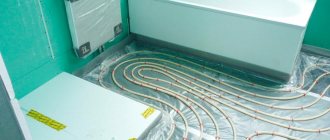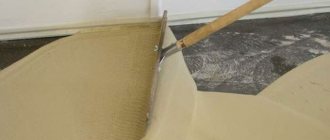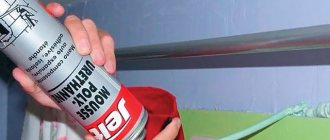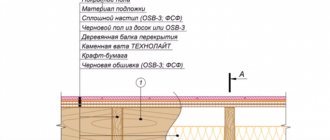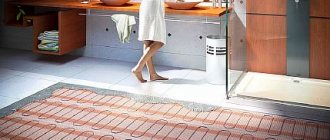All apartment owners are prohibited from connecting water heated floors directly from a heated towel rail. Firstly, these actions relate to illegal redevelopment, and secondly, an unaccounted amount of thermal energy is consumed, for which all residents of the entrance/house pay.
However, there is a legal way to use a water heat exchanger in an apartment - installing a heat exchanger. According to existing standards SP, SNiP, water heated floors can be installed only in bathrooms of a combined type, toilets and bathrooms; wiring above living rooms is prohibited on all floors of an apartment building, except for the first lower level.
Design and principle of operation
There is no requirement for a heated floor in a bathroom such as uniform heating of the air in the room; it is only important that its surface is always at a comfortable temperature and dry, so that drops and splashes quickly disappear. This is the wettest area in the apartment, if the heating from the heated towel rail is not enough, fungi and mold appear here, and a musty smell.
A heated floor system will help create an optimal microclimate and eliminate excess moisture. It can be based on an electrical or water circuit. The latest variation is based on metal-plastic or plastic pipes enclosed in a screed; heated coolant moves through them. This is an economical solution, but it is characterized by complex installation.
An electric heated floor, even in a bathroom, is absolutely safe; all its functional components are reliably isolated in an underground “pie”. In this case, power is supplied via a cable. There is a modernized variation of it - an infrared film floor: when installing it, you do not need a screed, it is possible to regulate the temperature, and installation is carried out directly under the decorative coating.
It is customary to install a water system in tandem with a heated towel rail, since there is no electricity consumption and the heated coolant is supplied directly from the hot water supply system.
general information
With the adoption of SNiP 2.04.01‑85, in which the term “towel rail” appeared, the device soon came into general use.
Unaesthetically pleasing and, moreover, useless at the end of the heating season, iron structures painted with “silver” or nitro paint, nevertheless appealed to the taste of householders, and soon they began, by hook or by crook, to obtain and install nickel-plated, graceful, elegant and practical European units.
This topic has not lost its relevance even now: in the housing stock there are still many old buildings, where apartment owners, starting repairs or replacement of plumbing equipment, turn their attention to such useful and necessary devices for equipping a bathroom, which are quite within the capabilities of a home handyman. self-installation
Types of heated towel rails
A heated towel rail is a special type of radiator in the shape of a coil; the working fluid circulates through a curved pipe. The water model is used complete with fittings that provide connection to the hot water supply system; electric variations have a built-in heating element. The operating principle of both devices is the same: the pipe, heating up along with the energy carrier, dries the air in the room and removes moisture from hanging towels. In the standard version, the battery is fixed to the wall.
Water
It fits into the heating and hot water supply system; this is the most common design option. It is independent of power supply and has the following advantages:
- ease of execution,
- safety,
- unpretentiousness in maintenance,
- loyal price range and variety of models,
- effective completion of the assigned task.
But there are also weaknesses:
- complete dependence on the supply of hot water or heating;
- the formation of a layer of corrosion and scale from the inside, which affects the ability to heat the body.
Water heated towel rail
We must not forget that air pockets often form in such systems.
Electrical
They are full-fledged radiators with a closed circuit. Their dimensions are slightly larger (due to the design features), they can be installed in any area of the bathroom, as long as the cord reaches the outlet. Electric models can be oil-based, they are attractive due to their high heat capacity, and “dry” - they do not contain a working fluid, a cable is laid.
Advantages of the line:
- long service life;
- reliability in use;
- moderate energy consumption;
- The device can be turned on and off as needed.
The downside is complete dependence on the electricity supply; products are sold in a high price segment. Electrical variations can be supplemented with useful options - thermostat, timer, automatic safety equipment.
Electric heated towel rail
On the specialized market there are universal models that combine the positive properties of both categories; they are connected to the electrical network and heating. With the correct installation, the dryer will delight you all year round: in the summer from the mains, and in the winter from centralized heating. The only difficulty is choosing the optimal installation location.
Heat exchanger
The most optimal solution would be to use a unit with a pump and heat exchanger. In the latter, the coolant is heated. In this design, it is possible to achieve full hydraulic independence.
It is best to connect the pump in series to the heated towel rail. In addition, a bypass must be installed. If you perform a parallel connection, the same disadvantages will appear as with a direct connection. And the main disadvantage is the low fluid flow.
Combination methods
A heated towel rail is a specific heating device that heats a bathroom, used for drying a variety of small textiles. Warm floors are installed in tandem with a water appliance.
Heated towel rails can be connected to one of the following types of pipelines:
- to centralized heating - this is an extremely rare option;
- to the main riser;
- to the hot water recirculation branch.
These varieties differ in operating modes and diameter. If you connect a heated floor to the first option, it will heat only during the heating season. When introduced to the recirculation line, additional heating occurs when the taps are open. An alternating mode is formed when tied to a riser; this option is not rational, as it exhibits low productivity.
Warm floors are connected to the heated towel rail in parallel, in series or through a circulation station. The first two methods affect the hydraulic parameters of the riser. A circulation unit equipped with a heat exchanger allows you to separate the functionality of the heated towel rail and the heated floor circuit.
Parallel connection
It is implemented using tees: the pipe serving the underfloor heating is connected using shut-off valves. A mandatory component is a control valve that allows you to coordinate water flow.
The solution has a significant drawback: there is a high probability of an insufficient volume of coolant passing through the circuit. The reason for this effect is the hydraulic resistance of the circuit is higher than that of a heated towel rail. To ensure complete circulation of water, you will have to limit the flow of the latter by closing the inlet or outlet tap. But this measure may cause discontent among neighbors, since a general weakening of the flow is likely.
A solution could be a low-power circulation pump with a capacity of up to 50-70 W; it will forcibly pump the working environment. In this case, energy costs will arise.
Sequential
The junction point becomes the cut of the riser; in this scenario, both heating devices will function simultaneously. The riser is turned off, a section of the pipeline is cut out of it, a ball valve and valve (or 2 valves) are inserted into the cut, and the circuit pipeline is connected through them.
Installation diagram for underfloor heating from a heated towel rail
The disadvantage of the solution is the occurrence of large resistance in the operation of the riser. The effect will be enhanced if you tighten the control valve. The use of a circulation pump is not recommended here; it will only be an additional obstacle.
Scheme with heat exchanger
The optimal solution to the issue under consideration is to use a unit with a heat exchanger and a pump. The working medium circulating in the pipes of the circuit is heated by water in the heat exchanger. In such a connection, full hydraulic independence is formed.
It is recommended to connect the pump in series with the heated towel rail; in addition to the station, a bypass must be installed. Parallel implementation in this case is accompanied by the same disadvantages that are inherent in direct connection, one of them is an insufficient flow of heated liquid.
What is required for installation
Before starting any work, it would be a good idea to sketch out a wiring diagram or, in extreme cases, a small freehand sketch of the placement of the unit, choosing the most suitable option for connecting the device to the pipeline network.
The simplest diagrams for the correct connection of a heated towel rail with your own hands using universal ladder devices:
Tools
To replace or install a water heated towel rail, you will need a set of plumbing tools, the composition of which depends on the type of water pipes in the apartment. Considering that copper, polypropylene and other modern types of pipelines are still rare, we will describe the tools for standard ¾' steel pipes:
- Keys: gas No. 2 or No. 3; adjustable - “crocodile”; adjustable nut.
- Pipe cutter or hacksaw for metal.
- Threading dies ¾' with lever handle.
- Electric drill with hammer drill, drill bits for concrete.
- Angle grinder with cutting disc for metal - “grinder”.
- Fastening tools: hammer, screwdrivers, pliers.
- Marking tool: tape measure, level, pencil.
Materials
In addition to a set of tools for work, installation and consumables are also required:
- Turns, bends, couplings, bends and possibly other types of fittings.
- Shut-off valves, preferably ball valves.
- Plumbing linen tow or FUM mounting tape.
- Installation and fastening parts: brackets, screws, dowels, anchor bolts, etc.
Having prepared everything you need, you can start working.
It is best to carry out all work on the heating pipeline in the summer, when the system is turned off, there is no pressure in it and the water can be drained from the riser without any problems. But in this case, after finishing the work, it will be impossible to test its quality: you will have to wait until the start of the heating season.
How to make a heated floor from a heated towel rail: work sequence
The first step is the complete dismantling of the old floor covering, the concrete base is exposed, from which dust and dirt are thoroughly cleaned. The base is waterproofed and leveled.
The purchase of materials is preceded by the drawing up of a detailed diagram on which indicators such as the diameter of the elements and their length, the location of the return and supply are recorded. It is also necessary to provide high-quality waterproofing, which will become full-fledged flood insurance in the event of damage to the components of the water heated floor. Next, thermal insulation is laid, which prevents heat leakage downwards.
Operating procedure:
- The specifics of the assembly of the structure are determined by the base material. Polypropylene pipes are combined using fittings. Metal-plastic ones are chosen and purchased so that during installation as few joints as possible are formed. Products made of stainless steel or copper are mounted using corners made of a similar material.
- The components are fixed to the floor surface using clamps.
- Connecting couplings are necessary for inserting the circuit into the system. It is important to avoid sharp turns in the pipeline.
- The next layer is a reinforcing mesh, which is necessary to increase the strength of the screed.
- A compensation damper tape is glued along the perimeter of the walls, with which you can avoid cracking of concrete due to expansion of the material when drying.
- The mixture is poured over the exposed beacons. Depending on the thickness, it will take a couple of weeks to dry; it is recommended to moisten its surface with water from time to time to prevent drying out.
After connecting the circuit to the radiator, the system is tested and the finishing cladding is laid - tiles, self-leveling flooring, linoleum.
How to lay infrared film?
Preparatory work is carried out as in the version with cables. Sheets of film are laid parallel to the thermal insulation material, retreating approximately 20 cm from the wall. A distance of 30-50 mm is left between the strips of infrared fabric.
Laying sheets of infrared film overlapping is prohibited.
Next, a thermostat with a sensor is installed, then their functionality is checked.
Carefully cover the device with infrared film with a reinforcing mounting mesh so as not to touch the contacts, and secure it with self-tapping screws. The structure is filled with cement screed.
You need to wait until the concrete mortar has completely dried, then lay the tiles on the adhesive, which will be the finishing coating.
System check
Before filling the working structure with concrete or its analogues, check the tightness of the system: open the taps to release air and fill the circuit with water.
Before proceeding to pouring the concrete mixture, the pipes are filled with cold water so that a pressure of 2 atm is maintained. This makes it easier to detect any leaks during inspection; if there are none, you can proceed to pouring the screed. To improve the quality of the mixture used, it is advisable to introduce a plasticizer into it. It is optimal if the thickness of the formed layer exceeds 6 cm. After the concrete has completely dried, you can cut off the protruding sections of the compensating tape and proceed to the formation of the final floor covering.
After filling, you need to wait 3-4 weeks before turning on the system in heating mode for the first time. Over several days, the temperature is gradually raised to the required level.
Connection to individual heating
Another connection method is to use an individual heating system. In this case, everything is much simpler, because you do not need to obtain any permits. This scheme has virtually no disadvantages. As a rule, such a scheme may include the following elements:
- Thermostatic valve. It receives a signal from the installed temperature sensor to turn the heating on and off.
- Balancing valve. Thanks to this, idling of the coolant in the circuit is completely eliminated. If the coolant is not supplied, then it starts heating in a small circle without a boiler.
- Circulation pump. This device allows you to achieve a uniform temperature over the entire floor area.
- Safety thermostat. Its installation is carried out on the feed. It controls the temperature of the coolant in the entire underfloor heating system.
- Electric drive. It is used to control the valves of each circuit.
- A collector that distributes coolant flows across different circuits.
- Remote temperature sensor. The heating floor sensor is connected to the entire control unit.
Features of operation
Experts recognize the connection to a heated towel rail as an unreliable way to provide additional heating in the bathroom. This is a complex design, and the usefulness of its operation depends entirely on the correct installation. In addition, if the supply of hot water is intermittent, the floors will periodically be cold, which is unpleasant, given the money and effort spent on modernization.
If the coolant is supplied to the pipeline under low pressure, its performance leaves much to be desired due to the rapid cooling of the water.
We must not forget about emergency situations: in the event of damage to the circuit, there is a high risk of flooding the apartment from below. To restore the system, you will have to dismantle the finished floor covering and concrete screed.
What to expect
We would like to immediately warn you that high-quality installation of heated floors from a towel dryer requires certain calculations, knowledge and skills, otherwise you will inevitably encounter the following problems:
Too hot towel dryer. A floor surface that is too hot can also become a problem if your appliance is working too hard. Sometimes it is not possible to reduce the temperature of the dryer, and then the whole installation does not make sense. In different buildings there may be problems with hot water, and if at the same time you have an underground structure, then it will make the surface not just cold, but icy
This point must also be taken into account during installation. The problem can be solved by installing a temperature control meter. If you do not work properly, you risk disrupting the normal supply and leaving both your own and your neighbors’ living space completely without hot water. Too much pressure in a set with an accidental kinking of pipes leads to a breakthrough of the entire structure, after which the illegal installation of the floor will be revealed and the results can be the most unpleasant. If you were planning to contact specialists, you will most likely receive a refusal, since, in general, companies do not want to get involved with criminal types of installation.
Warm floor from towel dryer
If you are not afraid of this kind of complexity, you can try installing a heated floor from a towel dryer yourself. There are several important connection types for this.
Parallel connection
This connection option can be made using tees. The tube that goes to the floor system is connected using a tap. It is imperative to install a valve that allows you to regulate the coolant flow. This connection option has one drawback - the likelihood that an insufficient volume of liquid will pass through the system is extremely high.
This occurs due to the fact that the circuit resistance is higher than that of the heated towel rail. To ensure proper water circulation, it is necessary to significantly limit the consumption of the heated towel rail. To do this, you need to cover the inlet or outlet valves. It’s just such actions that can affect the overall pressure in the house.
A good solution is to install a low-power circulation pump (50 W is enough). With its help, the entire system can be filled with coolant. You just have to spend money on electricity.
Serial connection
The junction point is located in the section of the riser. When implementing such a scheme for connecting a heated floor from a heated towel rail, both devices will be able to operate simultaneously. It is necessary to disconnect the riser and cut out a section of pipe from it. A tap and valve are installed in the section (2 valves can be used). It is through these fittings that the pipeline is connected.
The disadvantage of this solution is that there may be a lot of resistance in the operation of the riser itself. And if you attach a valve to it for adjustment, the negative effect will only intensify. It is highly undesirable to install a circulation pump, as it will be an obstacle.
